|
|
|
| Got a photo? See bottom of page | Kingdom Center
Height to roof: 302 metres
The Kingdom Center is one of only two giant skyscrapers in Riyadh. It was planned to be an icon of the city, so the designers came up with a novel top to the building - a giant U shaped opening taking up a third of the building, with a skybridge capping the summit. The tower is clad mostly in glass and rises from a complex which boasts a five star hotel, sports club, wedding banquet hall and luxury apartments. The arch at the top required complex structural engineering - while appearing smooth and simple on the outside, on the inside it is full of a web of interconnecting steel beams. The arch also solves the problem of Riyadh's building laws, which prohibit building higher than 30 stories. Unoccupied floors/spaces are not included in the count, thus allowing for the building's great height. |
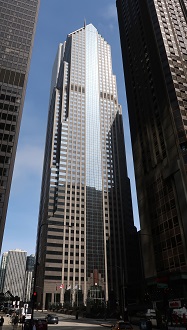 |
2 Prudential Plaza
Height to roof: 279 metres
This 64 storey building is part of the Prudential Plaza complex, the first stage of which was completed in the 1955. It was the second tallest concrete supported structure in the world when completed. It has multiple gables on its 42nd and 52nd floors, and a triangular peaked roof. While an impressively tall building in its own right, it is dwarfed by the nearby Aon Center which is almost 70 metres higher than its roof. The 2 Pru is clad in two shades of grey granite and reflective glass. It rises from a one acre plaza with terraces and fountains. |
| Got a photo? See bottom of page | Baiyoke Tower II
Height to roof: 304 metres
The tallest hotel in the world title is fuzzy at present - the Baiyoke Tower II is the tallest hotel in the world to the roofline, however, the Burj al Arab has a high spire, and the Ryugyong Hotel in North Korea, which is currently a decaying abandoned shell, is unoccupied and incomplete. The first Baiyoke Tower was built in 1987 and of modest height. A year later the Baiyoke Tower II project began. The base is gigantic and clad with red sandstone, with punched windows. The higher it goes, parts of the building set back geometrically, with gold coloured chevrons at mid height. At the top the stone is replaced with a circular blue and gold glass covered cylinder with a cap of sorts containing a public observation deck. The gold colour scheme was meant to symbolize wealth. |
 |
Chase Tower
Height to roof: 305 metres
When completed in 1982 the Texas Commerce Tower (now Chase Tower) was the tallest building outside Chicago and New York, the two giant forests of skyscrapers. It is clad in grey polished granite, stainless steel and grey glass. The tower shape was derived from a square prism rotated 45 degrees and one corner sheared off to form a five sided structure. The fifth new side is a span of jointed glass and stainless steel spandrels providing an impressive view of the city for tenants. The plaza is clad in granite and is bordered on both sides with landscaped gardens. Its focal point is a bronze and steel sculpture. There is a public observation deck at the top of the structure. |
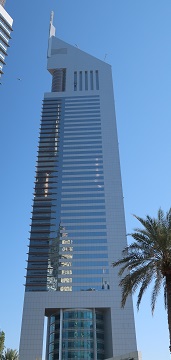 |
Emirates Tower II
Height to roof: 261 metres
The Emirates Tower II is the shorter of two twin towers in Dubai, a rapidly developing city. A three storey podium containing a mall, leisure areas and parking spaces connect the two towers. Each tower is clad in aluminium, copper and reflective glass. Eight storey glass drums form the base of each tower. |
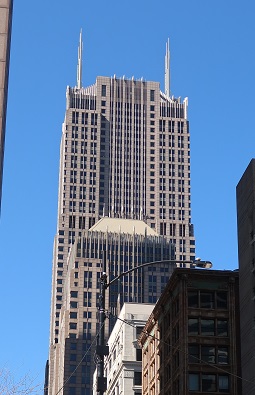 |
AT&T Corporate Center
Height to roof: 270 metres
AT&T Corporate Headquarters is a 60 storey tower in the heart of Chicago's business district. The building changes colour as it rises- from deep red to light rose. Granite and glass were used as cladding. At the 30th, 45th and 49th floors there are setbacks which correspond to the termination of elevator banks. The top of the building is crowned by four spires decorated with fins and metalwork. Its height was originally listed as 270 m but updated to 307 m when the Council of Tall Buildings and Urban Habitat decided the spires should count on a building. |
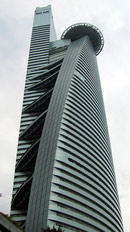 Photo by Damien Koh |
Menara Telekom
Height to roof: 310 metres
This 55 storey building is Kuala Lumpur's second tallest skyscraper. Two blade shaped structures side by side form the elliptical floor plan and are linked together by the framework of sky gardens. The smaller shell is topped by a helipad. The overall organic massing of the tower was influenced by the Malaysian painter Latiff Mohidin and also the shape of a bamboo sprout. The grey spandrel cladding and window shades give the tower a futuristic appearance. The tower is flanked by an auditorium, exhibition center, cafeterias and restaurants. The whole complex is situated along the Federal Highway, outside of the main city. |
 |
US Bank Tower
Height to roof: 310 metres
The Library Tower is a 75 storey skyscraper in downtown Los Angeles. The building's plan is cylindrical, with a multifaceted glass crown on top. There are four glass-crowned setbacks at the 48th, 57th, 61st and 69th floors. Light granite and glass were used as cladding. The building was designed to resist an earthquake 8.3 on the Richter scale. A helicopter landing pad, the highest in the world, is on the roof. Los Angeles requires all skyscrapers to have helicopter pads for evacuation during fires - this stems from a 1988 fire in the 60 storey Aon Center. As a result Los Angeles is dominated by flat-topped skyscrapers. Originally the top of the building was signless, then the giant "I" logo of First Interstate Bank was added, then removed, and at present the giant US Bank logo is affixed. |
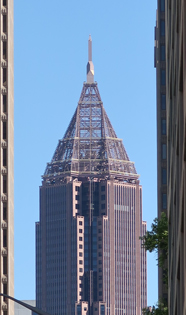 |
Bank of America Plaza
Height to roof: 283 metres
The Bank of America Plaza is Atlanta's tallest building. The building is square in plan, rotated 45 degrees to the site, and steps back as it rises. Notched corners step back at the 41st and 52nd levels. The building is clad in red granite and gray glass. A 30 metre fiberglass spire is supported by a stepped pyramidal cage and is covered in gold leaf. The pyramidal cage contains mechanical equipment and has an internal ladder reaching the spire for maintainence. It was built in only 14 months, an amazingly short time considering most skyscrapers its height take several years to construct. |
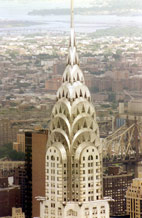 Photo by Damien Koh |
Chrysler Building
Height to roof: 256 metres
The Chrysler Building is one of the most well known and highly regarded skyscrapers in the world. It was built during the Great Depression as the headquarters of the Chrysler Automobile Company. It was the tallest building in the world for only 4 months - the following year the Empire State Building opened. The Chrysler is clad in brick with a slender shaft rising from a stepped base with alternating bands of white and black bricks. At a setback near the top eight gargoyles - but styled after American eagles - adorn the building. The square top then diminishes towards the spire in a series of stacked concentric arcs clad in stainless steel. Each arc has distinctive triangular windows, with their outlines presently lit up at night. The spire was added to the design secretly in order to top a rival office tower, the 40 Wall Street Tower, which was being built downtown. |
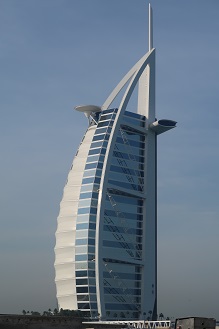 |
Burj al Arab
Height to roof: 273 metres
The Burj al Arab is certainly one of the most distinctive skyscrapers in the world. It is also one of the most luxurious. It 202 duplex suites, some costing 50 000 US dollars a night. With large ceiling heights of 7 m (office towers range from 3.5 - 4 m and apartments 2.6 - 3 m) the tower only has 28 stories. The shape of the tower was influenced by sailing ships. The sail is suspended from a steel supports with a straight mast at the top and two curved supports. In cross section the tower is V shaped, with a large 180 m high atrium. A helicopter landing pad is cantilevered off the roof, while the spire soars above. The whole complex is situated on a manmade island offshore. |
 |
Q1 Tower
Height to roof: 245 m
The Q1 tower is currently the tallest apartment building in the world. It rises among a forest of apartment and hotel towers lining the coast of Gold Coast City in Queensland. It has a lens shaped plan which is topped by a sloped roof and fin structure. A spire brings the tower past the 300 m mark, indeed, it is the first completed building in Australia to exceed 300 metres. The building has the highest swimming pool, the highest external balconies and the highest skygarden in Australia. However, its title may be lost to the Eureka Tower nearing completion in Melbourne. The 297 metre tower may have an observation mast added, which would take the total height to 355 m, taking the tallest crown. |
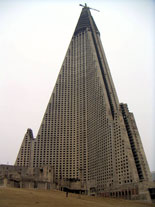 Photo by "uUN-DAENDA" |
Ryugyong Hotel
Height to roof: 330 m
The Ryugyong Hotel is certainly the most mysterious skyscraper in the world. It is located in North Korea and for many years little was known about this massive structure. It began construction in 1987 and the concrete frame reached full height sometime before 1992. In 1992 construction was halted and the construction crane was left on top of the building. 14 years later, it still sits 330 m up at the building's summit. It is rumoured the concrete is of sub-standard quality and therefore the building is too unsafe for habitation. Tourists are not allowed to take photos of the building up close - but one has leaked onto the internet. It shows a bleak, decaying mountain of a building, with thousands of openings where glass windows should be, and floor numbers still painted onto the facade. It is uncertain whether this building will ever be completed or just eventually crumble to the ground. |
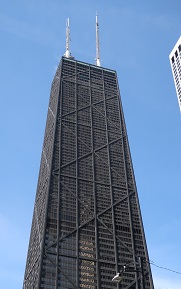 |
John Hancock Center
Height to roof: 344 metres
The John Hancock Center is Chicago's third tallest building. The building is a truncated pyramidal shape, clad with black aluminum and glass. 15 million dollars were saved in construction costs by adding giant X-braces to the exterior. There is a observation deck on the 94th floor and a restaurant on the upper two floors. There are 711 apartments in the John Hancock Center. The distinctive twin antennae masts were originally painted red and white, now they are grey. |
More buildings over 300 metres
Back to main page
Submit a building photo here